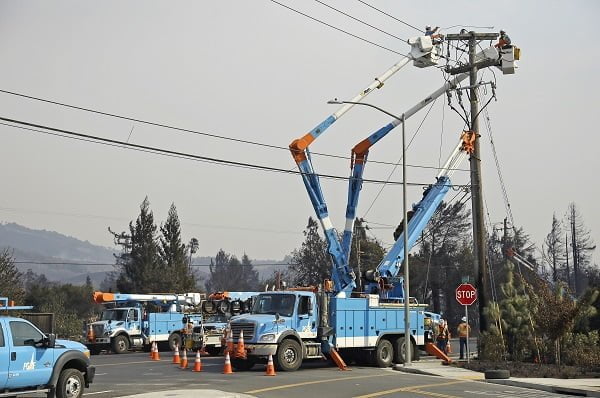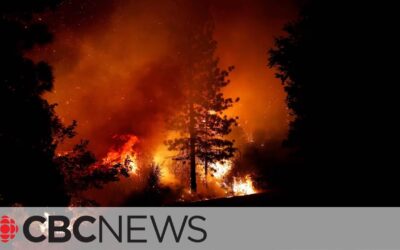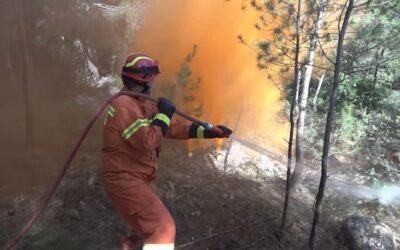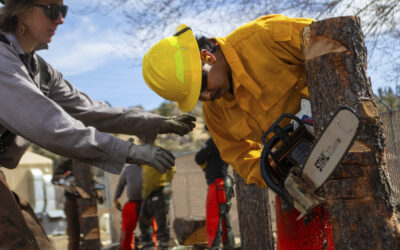What’s next for utility?

In this Oct. 11, 2017 file photo, a Pacific Gas & Electric crew works at restoring power along the Old Redwood Highway in Santa Rosa, Calif. Pacific Gas & Electric Co. was not the first utility to declare bankruptcy, not even when it did so in 2001. But when the nation’s largest utility filed again for Chapter 11 protection this week, it took a step no utility has in seeking shelter from potentially insurmountable legal bills because the company’s power lines are blamed for sparking deadly wildfires. (AP Photo/Eric Risberg, File)
By BRIAN MELLEY, Associated Press
LOS ANGELES (AP) — Big corporations forced into bankruptcy by liability lawsuits often take the offending product off the market and try to move on. That’s what happened with the Dalkon Shield birth control device, asbestos and silicone breast implants.
But when the nation’s biggest utility, Pacific Gas & Electric, comes out of bankruptcy, it will face the same danger that put it in financial peril in the first place: wildfires.
As the case makes its way through the courts, the industry and the public will be watching closely to see what steps PG&E takes to control its legal exposure to future blazes in an era in which climate change is likely to make such disasters more common.
Will PG&E invest more in preventive maintenance to keep power lines from starting fires, adopting more aggressive tree-trimming and brush-clearing practices? Will it fortify its equipment better? Will it shut off the power in certain areas when the fire risk is high?
“Where other companies have been able to say, ‘We’re going to deal with hazards we caused in the past through bankruptcy,’ PG&E somehow has to find a solution to the fact that California is going to have drought conditions for a very long time,” said Jared Ellias, a law professor at the University of California Hastings School of Law in San Francisco. “How do you solve the liability crisis that they face?”
PG&E is the nation’s first utility forced into bankruptcy by potentially massive legal bills from wildfires. It filed for Chapter 11 reorganization this week to deal with potentially tens of billions of dollars in claims over several of California’s devastating blazes in 2017 and 2018.
The company faced 750 lawsuits from fire victims and expected hundreds more, Stephen Karotkin, an attorney for PG&E, said at a court hearing Thursday.
One was the nation’s deadliest, most destructive wildfire in a century: the blaze in November that leveled the Northern California town of Paradise, killed at least 86 people and destroyed nearly 15,000 homes. The cause is still under investigation, though PG&E had reported problems with equipment near where the fire started.
PG&E was found responsible for 17 other fires that tore through Northern California since 2017.
The bankruptcy could lead to smaller payouts for fire victims, whose claims will most likely be heard by a judge, a step that could reduce the risk of excessive jury verdicts.
Attorneys for wildfire victims urged a bankruptcy judge at Thursday’s hearing to prioritize their claims and move fast. Some victims are facing the prospect of homelessness if they don’t receive a settlement soon, attorney Frank Pitre said.
PG&E wants to establish a trust fund for all the lawsuits that would expedite payments to victims, Karotkin said. The bankruptcy was not a “strategic ploy to avoid PG&E’s responsibility for the devastating damage and loss of life” from wildfires, he said.
The judge approved $1.5 billion in financing that the utility said it needed to keep operating.
The bankruptcy also could lead to higher bills for customers of PG&E, which supplies natural gas and electricity to 16 million people in Northern and central California.
The case could be an early glimpse of the financial pressures utilities could face as a result of climate change.
In the past, utilities have sought protection in bankruptcy court because of such things as nuclear reactors that didn’t pay off or costly fluctuations in the electricity market.
“This time around, you have a whole different problem,” said David Wiggs, who was chairman and CEO at the Texas-based El Paso Electric Co. in 1992 when it became the second utility since the Depression to declare bankruptcy. “Claims of fire damage are not normal. That is a lot of liability that is not your normal utility expense.”
Under California law, a public utility is liable if its equipment caused a fire, even if the company wasn’t shown to be negligent. Some of the lawsuits, however, have accused PG&E of inadequate maintenance and other failings.
PG&E will have to develop a business plan that shows it is not likely to end up in bankruptcy court again. How it does that is not clear at this point, but it may have to address how to minimize liability from future fires in a warming world.
Some possible solutions have been proposed in a separate criminal case where the company is on probation over a 2010 gas line explosion in the San Francisco Bay Area that killed eight people and destroyed 38 homes.
The federal judge overseeing that case criticized the company’s wildfire safety record and proposed earlier this year that it remove or trim all trees that could fall onto its power lines in high winds and shut off the electricity when fire is a risk, regardless of the inconvenience to customers or loss of profit.
PG&E has said that is unrealistic, it could cost $150 billion and that lives could be endangered if it cuts power.
As PG&E spends the next two to three years reorganizing, other utilities are likely to be watching.
“They’re on notice,” said Robert Rasmussen, a law professor at the University of Southern California. “I think a lot of these fires are caused by extreme conditions that are brought on by climate change. I’m sure they’re struggling with what to do.”
___
Associated Press writer Sudhin Thanawala and video journalist Haven Daley in San Francisco contributed to this report.
All contents © copyright 2019 Associated Press. All rights reserved.




